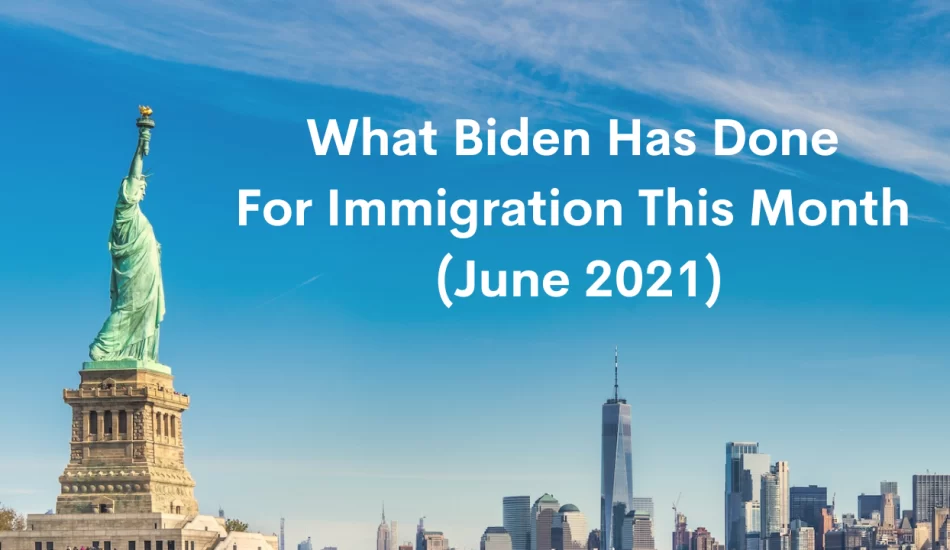What Biden Has Done For Immigration This Month (June 2021)

June is nearly over, and we are now officially halfway through President Biden’s first year in office. He has been making efforts toward meaningful immigration policy reform, which is especially important following the previous administration’s detrimental policy changes. To highlight some of the changes that have occurred in June 2021, here are the three main immigration policy and reform actions taken by President Biden and his administration.
1. Terminating “Remain in Mexico” & Reconsidering Asylum Cases Previously Barred by the Trump Administration
At the beginning of this month, President Biden officially abolished Migrant Protection Protocols (MPP), otherwise known as the “Remain in Mexico” policy. This policy, put in place by the Trump Administration, barred asylum-seeking migrants entering from the Southern border from entering the U.S. to apply for asylum. This policy forced migrants to remain in dangerous situations in Mexican border towns while waiting for their court dates. “Violence, kidnappings, and getting sick” are all reasons migrants would not be able to make their court hearings (USA Today, Morin)1. Under the Trump Administration policy, around 68,000 asylum-seekers were returned to Mexico (CNN, Alvarez)2.
As a result of terminating “Remain in Mexico,” the Biden administration is now allowing asylum-seekers whose claims were either denied or dismissed under the previous policy to have their cases reconsidered. Through this action, the government is taking one step in the direction of correcting its wrongs. Changing harmful policies and protecting those endangered or hurt by the prior policies is a move in the right direction.
2. Expanding and Streamlining Legal Immigration Processes
President Biden is looking to reverse low immigration caps created by the Trump administration in many different aspects of U.S. immigration, including family-based immigration, refugee admissions, diversity visas, and employment-based green cards. Specifically, the Biden administration has proposed a new refugee admission cap for 2022 to be raised to 125,000 refugees. Under the previous administration, the cap was set at 18,000 refugees in 2020 (Pew Research Center)3. Additionally, the new diversity visa cap will be increased from 50,000 to 80,000.
Not only is Biden planning on expanding limits on immigration, but with extensive plans of reform made by his administration, he would make immigrating to the U.S. far easier. Biden’s 46-page plan, released earlier this month, details specific ways to streamline immigration processes. Some specific, actionable improvements include creating shorter, simpler, and clearer forms as well as fewer security processes (New York Times, Shear, Kanno-Youngs)4. Streamlining these methods and processes would help to remove the heavy backlog in the USCIS application system.
In addition, the successful completion of Biden’s plan will reinforce and concretely demonstrate how the U.S. values immigrants.
3. Evacuating U.S.-Affiliated Afghans
The Biden administration has announced plans to evacuate Afghans who have worked with the government prior to U.S. removal from Afghanistan. This decision comes largely as a result of pressure from advocacy groups and impending threats on the lives and families of these individuals. Although it is unknown how many people will be evacuated, around 9,000 applicants are being considered for relocation as a result of reaching the end of the application process. The administration must also work within the deadline that has been set for extraction. September 11, 2021, is the end of the U.S. military presence in Afghanistan, and all evacuations must be completed by that date (Washington Post, Ryan, Gearan)5.
These plans signal that the U.S. government values and is working to ensure the safety of foreign allies, which is hopefully the type of action we can come to expect with other foreign allies in the future.
It is easy to see the progress President Biden has been making to the federal immigration system and that the current administration prioritizes positive reform moving forward. However, he must continue to take action and create specific policies to combat both the previous administration’s lingering broken immigration policy and the long-standing flaws in the U.S. immigration system.
